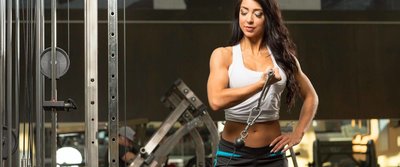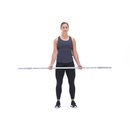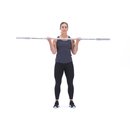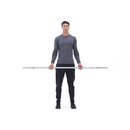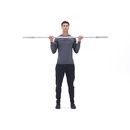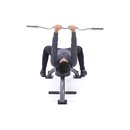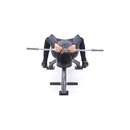Shoulders | Back | Arms | Chest | Legs | Abs & Calves | Final
Whether you're a novice or an expert in the field of fitness, you're probably aware that well developed arms are a badge of fitness for both women and men alike. The arms are probably the most viewed body part because they're so easy to show off with tight sleeves, short sleeves, cap sleeves, or no sleeves. So you can see the importance of a set of full, tight arms!
The arms are comprised of three major muscle groups—the triceps brachii, biceps brachii, and brachialis (forearms). The first group—the triceps—is responsible for extending both the elbow and shoulder joints. Well developed triceps look like an upside-down horseshoe on the back of the arm.
The biceps muscle group is used by the body to flex the elbow joint and to supinate the wrist (turn it outward so that the palm is facing up). Good biceps development is evident through full, round muscle bellies and a high peak. When viewed from the side as in a double biceps or a side triceps pose, the front and back of the arms should be of equal size and development.
The brachialis, or forearms, are the muscles that comprise the lower arm from the elbow joint to the wrist. Most women don't see the importance of training the forearms; however, strong forearms assist in back and biceps exercises and enable you to lift heavier and with proper form during your training sessions. They also add to the pleasing look of nicely developed upper arms by tapering down in size to the wrists.
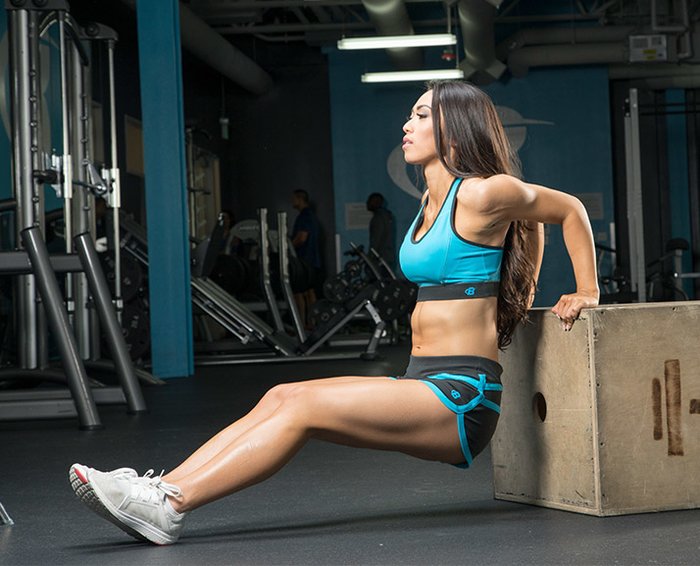
{{caption}}
Training Basics
Triceps
Compound Movements
The triceps are worked secondarily in most compound chest and shoulder exercises. By slightly altering these exercises, you can focus the movement to primarily target the triceps and secondarily work the chest and shoulders.
- Dips—Variations: Assisted, weighted (equipment: Seated machine, seated bench)
- Close-Grip Bench Press—Variations: Barbell, EZ bar, smith machine
- Close-Grip Push-Ups—Variations: One-arm
Isolation Movements
- Triceps extension—Variations: seated, standing, lying (equipment: barbell, EZ-bar, dumbbell, cable)
- One-arm triceps extension
- Cable bent-over triceps extension
- Incline cable triceps extension
- Kneeling (on bench) triceps extension
- Triceps press-down—Variations: one-arm (using "D" ring handle) (Handles: v-bar, straight bar, rope)
- Reverse press-down—Variations: one-arm (using "D" ring handle) (Handles: straight bar, double v-bar)
- Kickback—Variations: standing bent over, kneeling (equipment: dumbbell, cable)
Synergistic Movements
Incorporate these exercises into your chest, shoulder, back, and leg workouts to get secondary triceps stimulation.
- Bench Press (Chest)
- Push-ups (Chest)
- Military Press (Shoulders)
- Dumbbell Shoulder Press (Shoulders)
- Clean and Press (Shoulders)
- Push Press (Shoulders)
- Deadlifts (Back, Legs)
Biceps
To target the biceps through compound movements, you must target them secondarily through back exercises. There are a number of isolation movements to directly target the biceps, however, which definitely provides an assortment of options.
Isolation Movements
- Barbell curl—Variations: wide grip, normal grip, close grip
- EZ-bar curl—Variations: outside bend, inside bend
- Dumbbell curl—Variations: alternating, standing, seated (wrist positions: neutral (hammer), neutral to supinated, supinated)
- Cable curl—Variations: standing, seated on bench, seated on floor, lying (Handles: one arm, rope, straight bar, v-bar)
- Double-arm cable curl
- Preacher curl—Variations: dumbbell, EZ-bar
- Concentration curl—Variations: dumbbell, cable
- Incline curl—Variations: dumbbell, cable
- Prone incline curl—Variations: dumbbell, cable
Synergistic Movements
Add these exercises to your back workout to secondarily work the biceps muscles. Perform these movements with a supinated grip for increased biceps stimulation.
- Barbell Rows (Back)
- T-Bar Rows (Back)
- Lat Pull Downs (Back)
- Cable Seated Rows (Back)
Forearms
The forearms can be isolated through a variety of wrist curling and reverse wrist curling movements. Additionally, the forearms are worked synergistically in almost every back and biceps exercises.
As part of your back workout, almost all rowing exercises provide a great amount of focus on the forearms. During your biceps workout, perform your curling movements with either a neutral or a neutral to supinated hand position to better isolate the forearms.
Isolation Movements
- Wrist curls
- Variations: standing, seated, lying
- Equipment: dumbbell, barbell, cable
- Reverse wrist curls
Synergistic Movements
Include these movements in your back and biceps workouts to increase forearm stimulation. For ultimate forearm stimulation, perform biceps exercises with a supinated, neutral, or neutral to supinated grip.
- Pull-Ups (Back)
- Pull-Downs (Back)
- Barbell Rows (Back)
- Cable Rows (Back)
- T-Bar Rows (Back)
- Hammer (neutral) Curls (Biceps)
- Dumbbell Curls (Biceps)
- Rope Curls (Biceps)
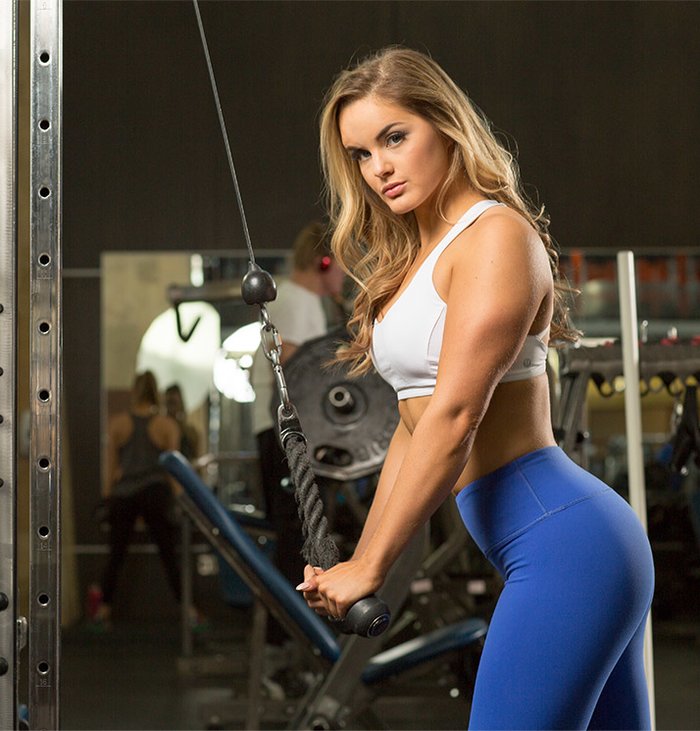
{{caption}}
Developing Your Training Program
When designing our arm training workout, you should choose 2-3 exercises for each body part. The arm muscles are very small, so they can easily become fatigued after only two exercises. It is very important to change up the order and type of exercises frequently to prevent overdeveloping one head of the triceps or biceps over the others.
Sets And Repetitions
Generally speaking, most people benefit from performing 10-15 repetitions and 2-3 working sets of a particular exercise. This will differ based on your training history, current fitness level, and goals.
Women focusing on maintenance should stick to 2-3 sets of 12-15 repetitions.
Individuals aiming for mass gains should perform 3-4 sets of 8-12 repetitions. In order to gain strength, you should perform 3-4 sets of 6-10 repetitions.
You can incorporate one, two, or all three rep ranges into your program for variety. For example, women looking to gain size and strength would do well to alternate the 8-12 and 6-10 rep ranges every other workout.
Additional Muscles Often Trained With Arms
There are many ways to structure your arms training, depending on the layout of your training split. If you are following a push-pull split, you should train biceps and forearms following back, and triceps following chest or shoulders. If you choose to split arms and pair them with these larger muscle groups, it is wise to train the arm muscles last in your workout.
Because they are the smaller muscle group and are recruited secondarily in most of the exercises for the larger group, the arm muscles fatigue quite easily. Training arms first would pre-fatigue them and disallow you from lifting as much weight when training the larger muscle groups.
Another training split option is to give arms their own day, in which case you could alternate between training biceps and triceps first, with forearms coming in last. This would be a good choice if arms are a lagging body part for you, and you wish to prioritize them. We will discuss prioritization later in this article.
Frequency, Duration And Intensity
One of the best styles of training is the split training technique, where each body part is worked once a week on its own day, or paired with 1-2 other muscle groups. This allows you to fully tax the muscle to stimulate new growth. If arms are a weak body part for you, you may wish to prioritize them by training them twice per week, or by setting aside an entire training session for arms alone.
Your training sessions should not last more than one hour. This is plenty of time to fully exhaust the targeted body part. If your workouts are lasting longer than this, you need to stop being so chatty at the gym—you are there to train, not make friends!
Because the muscles of the arm are so small and are largely targeted through isolation movements, the amount of weight you can lift will be limited. Make sure you don't sacrifice form for weight.
Keep the intensity high by limiting rest between sets, and by implementing super sets, negatives, and drop sets. Your arms should feel huge and tight after an intense workout, as well as burned out and completely exhausted.
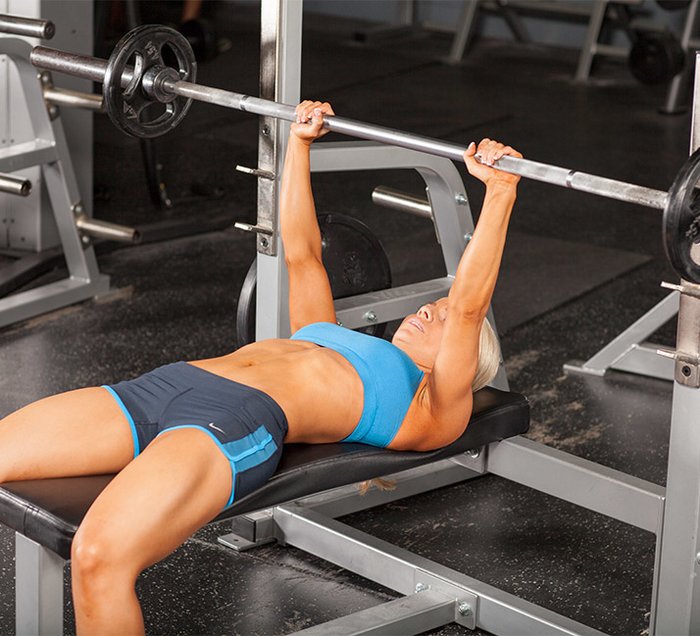
{{caption}}
Targeting Specific Goals
Adding Mass Safely
The arm muscles are small in size and are primarily targeted through isolation movements, which aren't the best for adding size due to the limitations on the amount of weight one is able to lift.
My three recommendations for adding size to the arms are to hit them heavy secondarily through a variety of compound movements, implement a variety of isolation movements to prevent adaptation, and keep the intensity ultra-high by using multiple shock tactics.
The first method—heavy secondary compound movements—can be implemented without changing your current training split. For biceps, change your back workouts to emphasize the biceps muscles. This can be done by performing rowing movements, pull ups, and pull downs with a supinated grip (wrist turned upwards).
If you train back and biceps separately, add one isolation exercise at the end of your back workout to get additional stimulation for growth. To implement this method into your triceps routine, perform your chest exercises with a close grip. During shoulder training, lock out the elbow at the top of the movement to recruit more triceps stimulation.
The biceps muscles are primed for growth in size and strength through one basic movement - barbell curls. This exercise is the bread and butter of biceps training, and if you aren't doing it, add it to your training program immediately! Use the pre-weighted barbells in your gym if you can't curl the Olympic bar, but work hard to build up your strength so that you can do Olympic barbell curls.
Just as the biceps are best hit through barbell curls, the triceps receive insurmountable stimulation through lying triceps extensions done with a barbell or an EZ-bar. Keep this exercise as a staple in your triceps program, and keep it heavy and intense to make the fastest gains possible.
The final method for adding size to your arms is to keep your workouts INTENSE! Shock tactics are a necessity, as is variety, to prevent your muscles from adapting to the load and halting in progress. My favorite shock tactic for biceps is drop sets, or running the rack. My favorite triceps shock is 21's. Other great options are super setting 2-3 exercises back to back, performing slow negatives, using the cheating method after failure to push out more reps, and minimizing rest time.
Training At Home
Arm training is fairly easy at home, but you do need some basic equipment. At a minimum, resistance bands or cables will allow you to perform many isolation exercises for your arms; however, the workload will not be very challenging, and once your muscles adapt, stimulation for growth will halt.
I recommend purchasing 3 sets of dumbbells and an EZ-bar with 3-4 sizes of weight plates. This will allow you to constantly increase weight and change up your training to prevent plateaus. Milk jugs and medicine balls can be used to perform curling exercises. Close grip and one arm push ups are great ways to train the triceps. Bench dips can be done at home on a chair or sofa.
Exercise Variety
Varying the exercises in your arm workouts is very important for two reasons.
First, the number of exercises necessary to fatigue your arms is so small that the muscle cannot be fully targeted from every angle in a single workout.
Second, the arms adapt quickly to a program, therefore a lack of variety results in a halt in progress. Implement as many of the suggested exercises as possible to provide a well rounded arm training program sure to garner the results you're after!
Symmetry
For those of you who compete or just want to look like your favorite competitor, symmetry of the arms is an important piece of your training program. Round, full shoulders should taper down to round and full biceps and triceps, which then taper down to the forearms. There should be visible separation between all three deltoid heads, the biceps, and the triceps.
The short and long heads of the biceps should be equal in size. To focus on inner bicep development, choose a wider grip during your curling movements. If increasing your biceps peak is your goal, choose exercises that allow for maximum contraction and constant tension, such as one arm cable curls. If your biceps peak is high yet you lack length, ensure you are training biceps with a full range of motion to work the muscle from top to bottom.
The three heads of the triceps should all be developed so that they are all visible and balanced in size as well. Dips and press down are good for overall size and upper triceps development, while kickbacks focus on size and the lower head of the triceps.
It is important as a bodybuilder to remain relatively lean, even during your gaining phases, so that you are able to visibly note the changes in your physique and to determine which areas need to be brought up to balance out your symmetry.
For instance, if you hit a double biceps pose and there is too much fat on the back of your arms, you won't be able to see the split of the biceps and triceps. You may also think you need more size and fullness in your triceps.
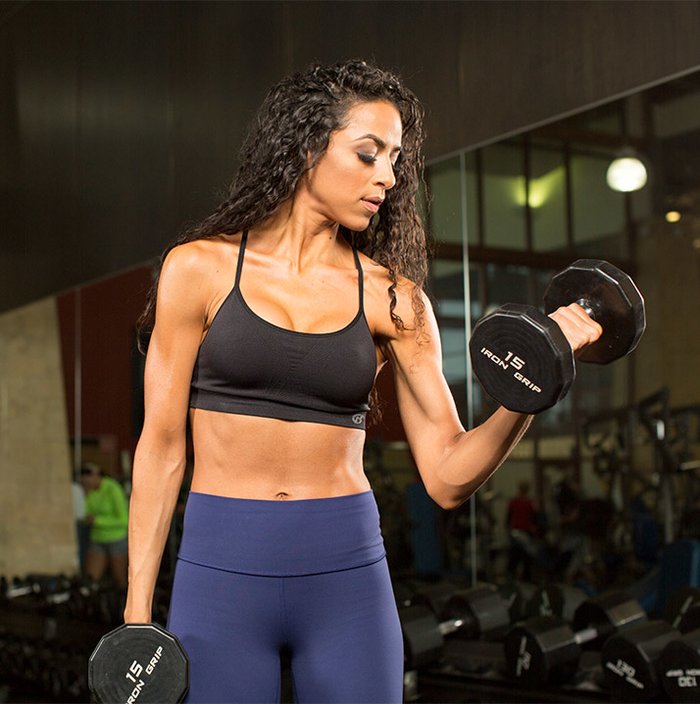
{{caption}}
Isolation
Isolating the biceps and triceps during training is usually not difficult, but there are several pointers to keep in mind to get even more out of your training.
The first tip, which applies to all exercises, is to be aware of your wrist position. It is imperative to keep straight, strong wrists to maximize isolation of the targeted muscle. If you find your wrists bending during an exercise, you either have too much weight or you need to add in additional training for your forearms and wrists.
In your triceps exercises, be sure to lock out the elbow on all the movements and squeeze the muscles at peak contraction. Your elbow should be the only joint moving during isolation movements; if your shoulder is moving you are wrong. During curling movements for biceps, curl the whole way up to your shoulder without compromising elbow position. The elbow must remain stationary in all biceps training to fully isolate the muscle. Give a good squeeze at the top of the movement to fully tax the biceps.
Prioritization
To prioritize the arms in general, I suggest training all the arm muscles in one workout on a separate day. In addition, focus some of your back exercises on biceps and some of your chest and shoulder exercises on triceps. You may also elect to train arms a second day during the week at a lighter intensity.
For biceps isolation, you may elect to pair biceps with a muscle group other than back to prevent pre-exhaustion during your biceps workout. This will allow you to lift heavier and harder during your biceps training. The same concept can be applied when isolating the triceps.
Train them on a day other than chest and/or shoulders. Not only will they get their own ultra-intense workout once a week, but they'll get hit secondarily during both your chest and your shoulder workouts. Whether you prioritize biceps or triceps, train them on day one of your program when you are at your freshest and motivation is high.
Go Heavy, Go Hard…
When you go heavy on your isolation movements, it is likely that your arms will fail in the lift before they are fully exhausted. To make sure you fully exhaust the targeted muscle, cheat reps can be utilized at the very end of a set. This is a great method for getting that last bit of energy out of and to fully exhaust the muscle fibers.
You can also give your arms an increased workload secondarily through heavy compound movements. Power movements designed to stress nearly every muscle in the body also work the arms to a great deal. Traditional dead lifts and clean and presses are two great options.
Both are outlined in the Ultimate "No Fluff" Training Guide for Back and Shoulders. Other great exercises include heavy barbell and t-bar rows for biceps, and push presses and military presses for triceps.
Sample Arm Training Program
I've designed three different workouts for three different training goals.
Workout 1 focuses on all the muscles of the arms and is ideal for the individual who wishes to prioritize arms in general.
Workout 2 focuses on biceps and forearms only, and is designed to be worked as is or with a body part other than back.
Workout 3 is solely focused on triceps, and should be worked alone or paired with any body part except for chest and shoulders.
If you wish to train biceps with back, perform Workout 2 and perform two of the listed biceps exercises.
To pair triceps with your chest and/or shoulders training, choose Workout 3, but only perform two of the three exercises.
Remember that these workouts are only guidelines. You should not perform the listed programs for more than two consecutive weeks without changing the order and type of exercises.

BodyFit
$6.99/month- 2,500+ expert-created single workouts
- 3,500+ how-to exercise videos
- Detailed workout instruction
- Step-by-step workout tips
- Training at gym or at home
- Access to Workout Plans
- Access to Bodyfit App
- Store Discounts
Already have a Bodybuilding.com account with BodyFit? Sign In

What comes with BodyFit?

- Instructional Videos
Don't risk doing a workout improperly! Avoid injury and keep your form in check with in-depth instructional videos.

- How-to Images
View our enormous library of workout photos and see exactly how each exercise should be done before you give it a shot.

- Step-by-Step Instructions
Quickly read through our step-by-step directions to ensure you're doing each workout correctly the first time, every time.

BodyFit
$6.99/month- 2,500+ expert-created single workouts
- 3,500+ how-to exercise videos
- Detailed workout instruction
- Step-by-step workout tips
- Training at gym or at home
- Access to Workout Plans
- Access to Bodyfit App
- Store Discounts
Already have a Bodybuilding.com account with BodyFit? Sign In

What comes with BodyFit?

- Instructional Videos
Don't risk doing a workout improperly! Avoid injury and keep your form in check with in-depth instructional videos.

- How-to Images
View our enormous library of workout photos and see exactly how each exercise should be done before you give it a shot.

- Step-by-Step Instructions
Quickly read through our step-by-step directions to ensure you're doing each workout correctly the first time, every time.

BodyFit
$6.99/month- 2,500+ expert-created single workouts
- 3,500+ how-to exercise videos
- Detailed workout instruction
- Step-by-step workout tips
- Training at gym or at home
- Access to Workout Plans
- Access to Bodyfit App
- Store Discounts
Already have a Bodybuilding.com account with BodyFit? Sign In

What comes with BodyFit?

- Instructional Videos
Don't risk doing a workout improperly! Avoid injury and keep your form in check with in-depth instructional videos.

- How-to Images
View our enormous library of workout photos and see exactly how each exercise should be done before you give it a shot.

- Step-by-Step Instructions
Quickly read through our step-by-step directions to ensure you're doing each workout correctly the first time, every time.
Note: Pyramid up in weight on every set. Each set should become increasingly difficult, and ultimate failure should be reached on the final two sets. Rest time between sets should be 1-1 ½ minutes.


